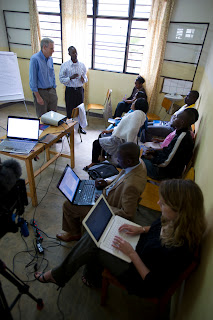Yesterday we spent the day at the Kinyinya clinic in Kigali. The Selenium Project was conducting the second of three trainings for the local medical staff that were conducting the trial. During the staff training, Andre and I had the opportunity to interview the principle investigators and trial research staff. This was the main objective for the trip here to Africa – background as the trial kicked off.
 The use of the micro nutrient of selenium has never been subjected to a clinical, double-blind trial. There has been subjective research and other trials using the organic compound with tremendous success, but in order for the true implications of selenium on the quality of life of HIV/AIDS patients a true clinical trial needs to be conducted. From a layman’s perspective, selenium is a vital micro-nutrient critical our bodies to fight infection. There have been studies that would suggest that the sub-continent of Africa’s soil has been depleted of the nutrient which effects overall health and nutrition of a massive population. To complicate this lack of selenium, the pandemic of HIV/AIDS attacks the immune system which becomes more susceptible to opportunistic infection of a variety of forms and the downward progression from HIV (the virus) to AIDS (the deterioration of ones body) begins. The study will recruit 300 patients from three Kigali clinics and prescribe the selenium in pill form. Of the 300, half of the patients will receive a placebo while the other half receives the selenium. It is not known by the patients, the clinical staff or the researchers which is given which. At the end of the 24 month trial the code will be broken by the selenium manufacture and the outcome should become apparent. All the participants, whether to have received selenium or the placebo will also be placed on the micro nutrient for one year after the trial.
The use of the micro nutrient of selenium has never been subjected to a clinical, double-blind trial. There has been subjective research and other trials using the organic compound with tremendous success, but in order for the true implications of selenium on the quality of life of HIV/AIDS patients a true clinical trial needs to be conducted. From a layman’s perspective, selenium is a vital micro-nutrient critical our bodies to fight infection. There have been studies that would suggest that the sub-continent of Africa’s soil has been depleted of the nutrient which effects overall health and nutrition of a massive population. To complicate this lack of selenium, the pandemic of HIV/AIDS attacks the immune system which becomes more susceptible to opportunistic infection of a variety of forms and the downward progression from HIV (the virus) to AIDS (the deterioration of ones body) begins. The study will recruit 300 patients from three Kigali clinics and prescribe the selenium in pill form. Of the 300, half of the patients will receive a placebo while the other half receives the selenium. It is not known by the patients, the clinical staff or the researchers which is given which. At the end of the 24 month trial the code will be broken by the selenium manufacture and the outcome should become apparent. All the participants, whether to have received selenium or the placebo will also be placed on the micro nutrient for one year after the trial.  Selenium, as this trial hopes to determine, can dramatically prolong the time period in which a person moves from infection of HIV to the manifestation of AIDS. This, to the doctors here in Rwanda, effects the HIV clients in a number of ways. First, this improved quality of life would be manifested in the overall population of communities throughout the nation. HIV/AIDS has ravished the nations most productive age demographic, 20-40. This infected population lives with a depleted quality of life, lack of energy and overall removal from the workforce. Although the current statistics indicate a national registered infection rate of 3% (rural) to 6% (urban) in the nation, this population is the most critical for the growth and prosperity of Rwanda. Added to those statistics is the difference between those infected and those affected. The onset of HIV/AIDS to one member of any given family or community has ramifications of far greater number of individuals within that community.
Selenium, as this trial hopes to determine, can dramatically prolong the time period in which a person moves from infection of HIV to the manifestation of AIDS. This, to the doctors here in Rwanda, effects the HIV clients in a number of ways. First, this improved quality of life would be manifested in the overall population of communities throughout the nation. HIV/AIDS has ravished the nations most productive age demographic, 20-40. This infected population lives with a depleted quality of life, lack of energy and overall removal from the workforce. Although the current statistics indicate a national registered infection rate of 3% (rural) to 6% (urban) in the nation, this population is the most critical for the growth and prosperity of Rwanda. Added to those statistics is the difference between those infected and those affected. The onset of HIV/AIDS to one member of any given family or community has ramifications of far greater number of individuals within that community. 
No comments:
Post a Comment